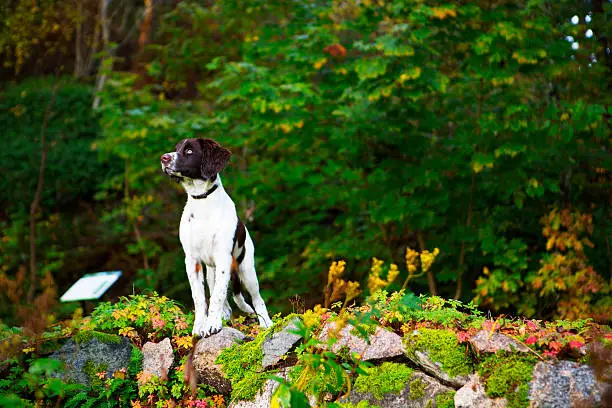This breed is pronounced da’rinse-ah puh’trice-hoon. The Drentsche Patrijshond, Drent for short, is not your typical continental pointer. For starters, the Drent has a tail and is nearly four hundred years old. The Drent was built by farmers for farmers. As a farm dog, Drents had to do it all: hunt feathers and fur, keep the farm clear of vermin, cart dairy to the market, and much more. The breed has maintained versatility from the beginning and is highly intelligent and adaptable. As such, training must be kept lively and interesting. Drents are used in all types of hunting, agility, tracking, dog sledding, and skijoring.
The breed originated from Spanish (Spioenen) pointing dogs that traveled through France to reach The Netherlands in the 16th century. These canines were known as partridge dogs in The Netherlands. These Partridge dogs were not crossed with other breeds as was commonplace elsewhere but rather were bred only among themselves in the Province of Drenthe. Three equally significant pillars have supported the Drent throughout its history: adaptable hunting dog, farmyard dog, and kid-friendly playmate. All upland game and waterfowl hunting, welcoming guests to the house or farm without displaying fear or hostility, and being a great family pet are essential traits of the Drent breed.
The Drent is used to hunt a wide range of wildlife and terrain. He is good for both waterfowl and all types of field games due to his flexibility. Additionally, he does an outstanding job cleaning up after the shot and is a skilled retriever. Because of these intrinsic qualities, the dog doesn’t require any field training. The dog is soft-natured, thus harsh training techniques are not suited. The Drent may be timid at first but never afraid because the dog is expected to bark to alert the owner to guests in the house and is frequently reserved about strangers until the owner welcomes them. In addition to being a good hunting companion, the dog is devoted, clever, and, with proper training, a pet of extraordinary value.




 Health
Health Grooming
Grooming Exercise
Exercise Training
Training Nutrition
Nutrition